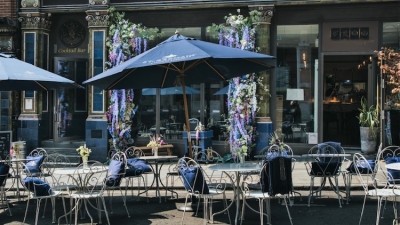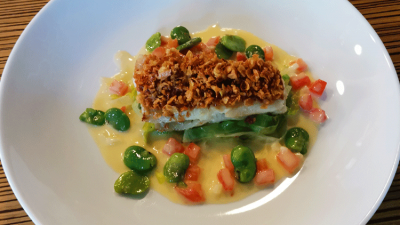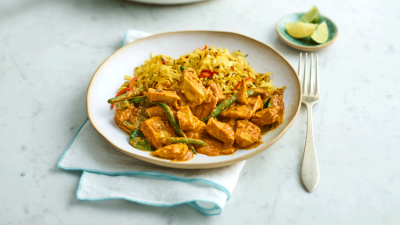Promotion
Downtime Development: Alaska black cod, green curry
Adam Handling is well-known in the industry for his drive, determination and ability to get projects off the ground quickly, but even by his standards setting up a full restaurant delivery service in five days is impressive.
Hame offers a number of dishes that would usually be served at the chef’s London restaurants Frog by Adam Handling, The Frog Hoxton, and Adam Handling Chelsea. And no, it’s not a typo – ‘Hame’ – is the Scottish word for home, a reference to Handling’s Scottish roots.
“It’s survival time for our restaurant group,” says Handling. “We had to move fast. We got 70 orders in the first 24 hours, so the initial signs are good. I’ve been getting asked about doing some sort of delivery service for years. I always resisted because I thought my food would arrive looking mangled and terrible.”
The solution to this is to supply the food chilled and ready to cook at home. Each dish has a QR code that links to a video of Handling plating the dish exactly as he would in the restaurants.
“You can follow me and do it in exactly the same way,” he says. “It’s my food, prepared by me but served by you in your own home. It’s interactive. I think people actually appreciate it a bit more if they’ve had to cook it themselves.”
Dishes available to order include The Frog’s legendary cheese doughnuts; Nanny Sophie’s fried chicken; and whole lobster with carrot and lemongrass.
There are also a selection of dishes that the chef restaurateur has developed while cooking at home during lockdown, including a sharing plate of beef wellington served with clotted cream mash, spring greens, and roast carrots.
The majority of dishes range from £20 to £40 in price, with larger sharing meals costing between £75 and £150. Initially London-only, Hame’s food is now available nationally.
Aside from the development work on Hame, Handling hasn’t had a great deal of time to think about new dishes because most of his waking hours have been spent working out how his restaurants will operate when they are allowed to re-open for eat-in.
“We’ve created a structure already. We’ve been thinking about how the space will work in terms of distancing,” he says. “We’re going to try and keep as much interaction as possible. That’s going to be hard given the circumstances, especially as we will have to reduce the staff count as we’ll be doing fewer covers.”
He is not planning to re-open with staff kitted out in gloves and masks. “That’s not hospitality for me,” he says. “If I went to a restaurant and my waiter was dressed like that it would freak me out. We need to change customer perception – we’re one of the safest and cleanest industries out there. We wash our hands constantly anyway.”
For this Downtime Development series Handling cooked a clever Alaskan black cod dish that showcases the ingredients affinity with powerful Asian flavours.
“Alaskan black cod is actually one of my favourite products. It’s durable and I also like the stunning white colour."
“Usually, I would cook it the traditional Japanese way by marinating it in miso for three days before grilling. But for this I’ve cured it in salt and roasted it before covering in a really fresh green curry butter."
"The dish is served with a carrot puree and a lemongrass-flavoured sauce. It’s a super-simple dish but has bags of flavour.”
Recipe: Black cod, green curry
Prep time: 1 hour
Ingredients
150g fillet of Alaskan black cod
For the green curry butter
250g Thai green chillies
250g green bell pepper
50g fresh coriander
20g galangal
25g garlic
25g shallots
25g lemongrass, chopped
25g shrimp paste
25g cumin powder
12g salt
30ml vegetable oil
250g unsalted butter
For the carrot puree
400g carrots
400ml carrot juice
7g sea salt
110ml extra virgin olive oil
For the lemongrass sauce
100ml extra virgin olive oil
5 shallots
5 cloves of peeled garlic
3 sprigs lemon thyme
30g sliced ginger root
50ml lime juice
½ litre white chicken stock
500ml double cream
1 Bunch lemongrass
10 kaffir lime leaves
8g sea salt
Method
1. For the lemongrass sauce, add the olive oil to a heavy-based saucepan and put over a medium heat. Toast the garlic first, then the shallots and cook until translucent. Add half of the ginger and caramelise everything for 15 minutes. Pour in the stock and reduce this by a third. Add the cream and bring to the boil. Remove the sauce from the heat and leave to cool down for 10 minutes. Add the lime juice, lemongrass and lime leaves and infuse for 20 minutes. Pass the infused sauce through a sieve to ensure a smooth consistency. On a high heat, reduce the sauce down by a further quarter.
2. For the carrot purée, thinly slice all the carrots and put them into a saucepan. Pour all the carrot juice over them and cook under a cartouche. Cook on a high heat until the carrots are tender. Drain off the liquid, add 7g salt to the carrots, and blend. When the mixture is smooth, continue to blend while slowly adding the olive oil, to emulsify the carrots.
3. For the green curry butter, blend all the ingredients together to make a paste. Incorporate the paste with the butter. Chill in the fridge until solid.
4. For the cod, add olive oil to a frying pan and place the fish, skin side down, into the pan. Cook on a high heat until the colour starts to whiten. Turn over the fish and add the butter. Baste the fish until cooked through. When the fish reaches 38°C, take it off the heat and leave it to rest for 3-4 minutes. The residual heat will finish the cooking.
5. To plate, spoon the carrot purèe onto the bottom of the plate. Place the fish on top of the purèe and finish by pouring the lemongrass sauce around the fish.
About Alaska Seafood
Wild: Fish from Alaska swim wild in the icy Pacific Ocean. This freedom to swim and the fish’s natural diet creates superior taste and texture. Wild Alaska seafood is firmer, fitter and a more vibrant fish.
Natural: Wild Alaska seafood has no artificial colouring, preservatives, pesticides or GMOs. Alaska’s fish live in some of the cleanest waters in the world.
Sustainable: Ticking the sustainable box cannot be easier when buying Alaska seafood. When Alaska was founded in 1959 the Constitution stated that their fish “be utilized, developed and maintained on the sustained yield principle”. In Alaska, “sustainable” applies to the fish, the local communities, the fishermen and women as well as well as the economic return.
Quality: Alaska seafood is a quality product that has some of the best credentials in the world - a product from a clean, wild environment that is respected by the people who fish it. Wild Alaska seafood is frozen within hours of the catch, often while still at sea. This ensures the fresh taste, vitamins and minerals are locked in from sea to plate. Time, temperature, and cleanliness maintain the quality of Alaska seafood.
Nutritious: Absolutely packed with the healthy Omega-3 fatty acid, DHA, which is almost exclusive to seafood and cannot be found in plants, many species of wild Alaska seafood contain exceptionally high Omega-3 levels, which helps to ensure a healthy heart, brain, immune system, vision, nerve cells and gums.
Fit Fish: Alaska fish are an excellent source of lean protein as well as other important vitamins and minerals like amino acids, selenium, Vitamins A, D, B, and vitamins from the B complex group.
















